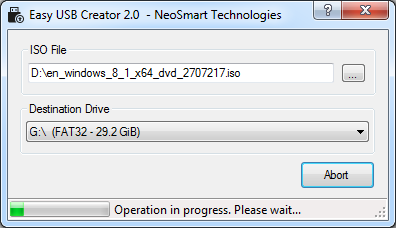
- #CREATE A BOOTABLE USB FROM WINDOWS ISO INSTALL#
- #CREATE A BOOTABLE USB FROM WINDOWS ISO UPDATE#
- #CREATE A BOOTABLE USB FROM WINDOWS ISO WINDOWS 10#
- #CREATE A BOOTABLE USB FROM WINDOWS ISO PRO#
- #CREATE A BOOTABLE USB FROM WINDOWS ISO SOFTWARE#
If this occurs, click Yes to automatically download the newest compatible version from the internet.
#CREATE A BOOTABLE USB FROM WINDOWS ISO UPDATE#
During this process, you may be prompted to update the menu.c32 file, as the one used by the ISO image may be older than the one used by Rufus on the flash drive. The transfer process will vary depending on the specifications of your workstation, but typically it should be completed within several minutes. Please note that any data on the drive will be erased ( Figure D). Figure Cįinally, click on the Start button to begin the process of formatting and partitioning the UFD and extracting the contents of the ISO to your USB drive. Skip down to the CD icon and click on it to select the previously downloaded VMware ESXi ISO image ( Figure C).

In the next section, Partition Scheme, select MBR Partition Scheme For BIOS Or UEFI from the dropdown menu ( Figure B). Verify that under Device, the UFD is listed ( Figure A). Start by inserting your UFD into the Windows computer and launching Rufus. SEE: VMware vSphere: The smart person's guide (TechRepublic) Creating the USB installer Internet access (optional, but recommended).Windows workstation (running XP or later).However, before jumping into this, there are a few requirements: Read on and we'll cover the steps necessary to create a bootable UFD, with VMware ESXi on it, from your Windows workstation. And given their flexible read/write nature, even updating installers is a breeze using the very same UFD. While many newer servers have added modern touches to facilitate VMware deployments, such as internal SD card readers for loading the hypervisor onto the SD to maximize all available resources, these servers have also done away with legacy items, like optical drives-and that makes loading VMware onto the servers a bit difficult initially.īut fret not, as USB flash drives (UFDs) have proven to be more than capable at replacing optical media for booting operating systems. It even has a free offering-ESXi-which is its base hypervisor that can be run on any bare-metal supported server hardware to get IT pros familiar with the product and help organizations on their way to migrating their servers to virtual machines.
#CREATE A BOOTABLE USB FROM WINDOWS ISO SOFTWARE#
With regard to consolidating servers by virtualizing them, the industry standard is VMware, with its extensive software and support offerings for businesses of all sizes.
#CREATE A BOOTABLE USB FROM WINDOWS ISO WINDOWS 10#

#CREATE A BOOTABLE USB FROM WINDOWS ISO PRO#
Pro Tip: If you are having issues creating your bootable USB thumb drive. The process may take several minutes depending on the speed of your USB thumb drive. Click OK on the confirmation screen to begin creating your bootable USB drive. The Format Options can usually be left as is, hit Start when you are ready. Once selected, just hit Open.įor image option, partition scheme and target system, I suggest using the defaults which are "Standard Windows Installation", GPT Partition Scheme and UEFI target system. If you need to download a Windows 10 ISO file, check out this article. Next, click Select and navigate to your ISO file you want to use. To be safe, I typically use a 16GB thumb drive by Transcend.īy default, Rufus will only display removable USB drives but make sure the correct device is selected under Drive Properties.

Make sure that your USB thumb drive is larger than the ISO file downloaded. Once installed, plug in your USB thumb drive and then start up Rufus. Alternatively you can download directly from the Github repository here. To get started, head over to and download Rufus 3.12 or later.
#CREATE A BOOTABLE USB FROM WINDOWS ISO INSTALL#
This is very helpful when performing a clean install of the Windows 10 20H2 October update ISO. But recently I switched to using a new tool called Rufus that is both reliable at successfully creating bootable media and automating many steps to quickly get the job done so you can perform a clean install. I've written about a few methods over the years to create a bootable USB flash drive from a Windows 10 ISO file.


 0 kommentar(er)
0 kommentar(er)
